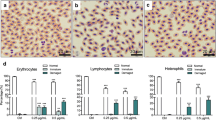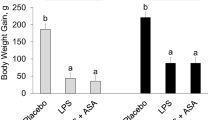Abstract
Lead (Pb) affects elements of humoral and cell-mediated immunity, and diminishes host resistance to infectious disease. Evidence is presented supporting a hypothesis of Pb-induced immunosuppression stemming from altered fatty acid metabolism, and mediated by eicosanoids and macrophages (MØ). Chronic Pb exposure increases the proportion of arachidonate (ArA) among fatty acids in lipid from avian tissues, and this change provides precursors for eicosanoids, the oxygenated derivatives of ArA that mediate MØ acute inflammatory response. In the current study, we showed that the concentration of ArA in phospholipids of MØ elicited from turkey poults fed 100 ppm dietary Pb acetate was twice that of controls. In vitro production of eicosanoids by these MØ was substantially increased, and this effect was most pronounced following lipopolysaccharide stimulation: prostaglandin F2α was increased 11-fold, thromboxane B2 increased threefold, and prostaglandin E2 increased by 1.5 times. In vitro phagocytic potential of these MØ was suppressed, such that the percentage of MØ engulfing sheep red blood cell (RBC) targets was reduced to half that of control MØ. In vivo susceptibility of Pb-treated and control birds to Gram-negative bacteria challenge was also evaluated. The morbidity of chicks inoculated withSalmonella gallinarum and fed either control or 200 ppm Pb acetate-supplemented diets was similar, except early in the course of the disease when mortality among Pb-treated birds was marginally greater. In these studies, effects of Pb that could influence immunological homeostasis were demonstrated for MØ metabolism of ArA, for production of eicosanoids, and for phagocytosis. There was also the suggestion that these in vitro indices of immune function are related to in vivo disease resistance.
Similar content being viewed by others
References
D. A. Lawrence, inImmunotoxicology and Immunopharmacology, J. Dean, M. Luster, and A. Munson, eds., Raven, New York, pp. 341–353 (1985).
F. Hemphill, M. Kaeberle, and W. Buck,Science 173, 1031, 1032 (1971).
J. Cook, E. Marconi, and N. DiLuzio,Toxicol. Appl. Pharmacol. 28, 292–302 (1974).
N. I. Kerkvliet and L. Baecher-Steppan,Immunopharmacology 4, 213–224 (1982).
J. Zelikoff, E. Parsons, and R. Schlesinger,Environ. Res. 62, 207–22 (1993).
S. Dey, D. Swamp, and S. Dwivedi,Indian J. Anim. Sci. 64, 1335–1338 (1994).
M. Governa, M. Valentino, and I. Visona,Arch. Toxicol. 59, 421–425 (1987).
J. MauËl, A. Ransijn, and Y. Buchmuller-Rouiller,J. Leukocyte Biol. 45, 401–409 (1989).
J. I. Kurland, and R. Bockman,J. Exp. Med. 147, 952–957 (1978).
R. Oropez-Rendon, V. Speth, G. Hiller, K. Weber, and H. Fischer,Exp. Cell. Res. 119, 365–371 (1979).
D. L. Hutchinson and R. L. Myers,Cell Immunol. 110, 68–76 (1987).
J. J. Lee and A. H. Battles,Environ. Res. 67, 209–219 (1994).
S. O. Knowles and W. E. Donaldson,Comp. Biochem. Physiol. 95C, 99–104 (1990).
K. Erickson, N. Hubbard, and R. Chakrabarti,J. Nutr. 125, 1683S-1686S (1995).
R. R. Brenner,Prog. Lipid Res. 20, 41–8 (1982).
S. O. Knowles, W. E. Donaldson, and J. E. Andrews,Biol Trace Element Res., in press (1997).
W. E. Donaldson,Biol. Trace Element Res. 7, 255–262 (1985).
National Research Council,Nutrient Requirements of Poultry. National Academy Science, Washington, DC (1984).
Chemical & Environmental Technology, Inc., Environmental Laboratory and Consulting Services, RTP, NC 27709.
B. Glick, K. Sato, and F. Cohenour,J. Reticuloendothelial Soc. 1, 442–449 (1964).
M. A. Qureshi, R. R. Dietert, and L. D. Bacon,Proc. Soc. Exp. Biol. Med. 181, 560–568 (1986).
K. A. Trembicki, M. A. Qureshi, and R. R. Dietert,Dev. Comp. Immunol. 8, 395–402 (1984).
H. J. Philips, inTissue Culture Methods and Application, P. F. Kruse, Jr. and M. K. Patterson, Jr., eds., Academic, New York, pp. 406–408 (1977).
V. Kaever, H. J. Pfannkuche, K. Wessel, and K. Resch,Biochem. Pharmacol. 39, 1313–1319 (1990).
H. F. Krug and H. Culig,Mol. Pharmacol. 39, 511–516 (1991).
V. L. Marcheselli and N. G. Bazan,J. Nutr. Biochem. 1, 382–388 (1990).
SAS Institute,SAS User’s Guide: Statistics. SAS Institute, Cary, NC (1987).
W. E. Donaldson and T. K. Leeming,Toxicol. Appl. Pharmacol. 73, 119–123 (1984).
D. A. Lawrence and M. J. McCabe, inMetal Toxicology, R. A. Goyer, C. D. Klaassen, and M. A. Waalkes, eds., Academic, San Diego pp. 305–337 (1995).
K. C. Klasing,Poultry Sci. 70, 1176–1186 (1991).
D. P. Speert, inThe Macrophage, D. C. Lewis and D. H. McGee, eds., Oxford University Press, New York, pp. 215–264 (1992).
H. L. Yin and T. P. Stossel, inPhagocytosis, M. Karnovsky and L. Bolis, eds., Academic, New York pp. 13–27 (1982).
P. C. Calder, J. A. Bond, and D. J. Harvey,Biochem. J. 269, 807–814 (1990).
A. L. Tappel,Arch. Biochem. Biophys. 50, 473–485 (1954).
J. F. Mead, inFree Radicals in Biology, vol.1, W. A. Pryor, ed., Academic, New York, pp. 51–68 (1976).
M. Chvapil, J. N. Ryan, and Z. Brada,Biochem. Pharmacol. 21, 1097–1105 (1972).
O. A. Levander, V. C. Morris, and R. J. Ferretti,J. Nutr. 107, 2135–2143 (1977).
S. J. Stohs and D. Bagchi,Free Radical Biol. Med. 18, 321–336 (1995).
A. A. Aderem, S. D. Wright, S. C. Silverstein, and Z. A. Cohn,J. Exp. Med. 161, 617–622 (1985).
M. B. Johnston, J. B. Hay, and H. Z. Movat,Am. J. Pathol. 95, 225–238 (1979).
M. A. Qureshi and L. Miller,Poultry Sci. 70, 530–538 (1991).
M. M. Mathias and J. Dupont,Lipids 20, 791–801 (1985).
J. E. Kinsella, K. S. Broughton, and J. Whelan,J. Nutr. Biochem. 1, 123–141 (1990).
A. KÄfer, H. Zöltzer, and H. F. Krug,Toxicol. Appl. Pharmacol. 116, 125–132 (1992).
J. S. Goodwin and J. L. Geuppens,J. Clin. Immunol. 3, 295–304 (1983).
S. L. Kunkel,Lab. Invest. 58, 119–121 (1988).
D. Lappin and K Whaley, inBlood Cell Biochemistry, V5: Macrophages and Related Cells, M. Horton, ed., Plenum, New York, pp. 115–148 (1993).
D. Lappin and K. Whaley,Clin. Exp. Immunol. 49, 623–630 (1982).
T. A. Hamilton, Y. Ohmori, S. Narumi, and C. S. Tannenbaum, inMononudear Monocytes in Cell Biology, G. Lopez-Beresteinand J. Klostergaard, eds., CRC, Boca Raton, FL, pp. 47–70 (1993).
W. Smith, T. Watanabe, K. Umegaki, and W. Sonnenburg, inEicosanoids in the Cardiovascular and Renal Systems, P. V. Halushka and D. E. Mais, eds., MTP, Boston, MA, pp. 232–248 (1988).
P. V. Halushka, D. E. Mais, P. Mayeux, and T. Morinell,Annu. Rev. Pharm. Toxicol. 10, 213–239 (1989).
K. A. Grasman and P. F. Scanlon,Arch. Environ. Contam. Toxicol. 28, 161–167 (1995).
C. H. Hill,Poultry Sci. 68, 297–305 (1989).
R. G. D. Steel and J. H. Torrie,Principles and Procedures of Statistics: A Biometrical Approach, 2nd ed., McGraw-Hill, New York (1980).
Author information
Authors and Affiliations
Rights and permissions
About this article
Cite this article
Knowles, S.O., Donaldson, W.E. Lead disrupts eicosanoid metabolism, macrophage function, and disease resistance in birds. Biol Trace Elem Res 60, 13–26 (1997). https://doi.org/10.1007/BF02783306
Received:
Accepted:
Issue Date:
DOI: https://doi.org/10.1007/BF02783306




